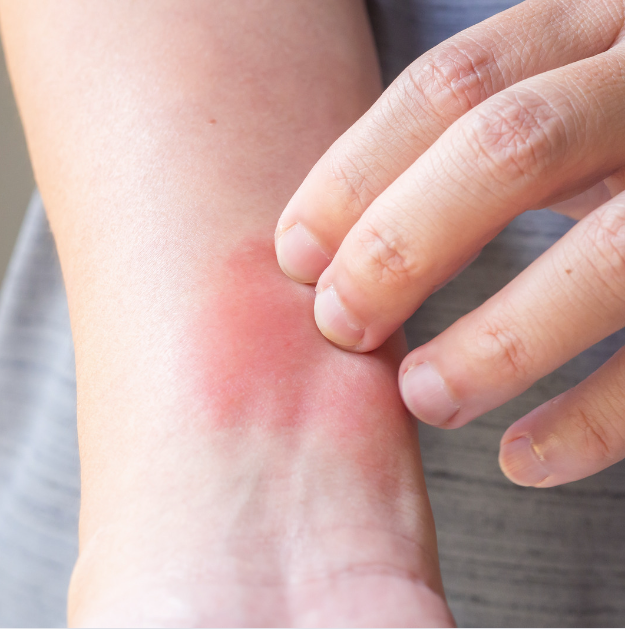
If you have histaminosis, what I'm going to tell you will be of interest to you.
My love-hate relationship with histamine 💔
A few years ago, my team of nutritionists and I were gathered for our weekly meetings to discuss histamine. We observed that what we had been taught about histamine fell short; that not all patients with symptoms of histaminosis improved with a low-histamine diet (headaches, digestive problems, itchy skin, eczema, fluid retention, rhinitis and runny nose, etc.).
Despite treating dysbiosis, managing stress, improving liver health, and reducing inflammation, while also ruling out allergies and other potential triggers, patients improved but were still far from fully recovered.
That's why we made a significant effort to find and investigate other possible causes and the relationship between histaminosis and food intolerances. Today, I'm sharing various findings and experiences with our team that have significantly helped us resolve the health problems of our patients with histaminosis.
What is histamine? 🤔
Histamine is a molecule we know primarily for its role in infections and allergies. 🌸 Histamine is produced by the body itself in response to allergic reactions within the immune system. In the face of an infection or allergy, white blood cells coordinate to release molecules that, when combined, increase their attack to eliminate the pathogen (parasites, bacteria, etc.), increasing inflammation and recruiting other immune system cells to resolve the infection as quickly as possible.
At the peripheral level (blood histamine), it regulates the frequency and strength of cardiac contraction, smooth muscle contraction of the respiratory tract and gastrointestinal system, allergic and immune responses, and gastric acid secretion. Histamine is also produced in the brain and regulates the sleep-wake cycle, motor behavior, water and food intake, sexual behavior, learning, and memory.
Who produces it? 🌍
Blood histamine is produced and stored primarily in mast cells and basophils (also in other cells, but in smaller quantities), located in the skin and respiratory tract. Therefore, the most common allergic reactions are located in the skin and respiratory tract. When an infection or allergic reaction occurs, mast cells release large amounts of histamine, causing symptoms such as itching and dilation of blood vessels, which are necessary to eliminate the microorganism.
In non-allergic food allergies or intolerances, the body recognizes an environmental agent or food protein as foreign, reacting as if it were a pathogen (a parasite, a bacteria, etc.), and we experience the same symptoms as if we had an infection.
How we removed it 🚮
The DAO enzyme removes extracellular histamine, and the HMNT enzyme removes intracellular histamine, especially in the brain. It is specifically removed through the hepatic methylation pathway, so methylation polymorphisms or cofactor deficiencies (vitamin B12, choline, betaine, folate, etc.) can lead to greater difficulties in eliminating excess histamine from the body. 🧬
Exogenous histamine: histamine in food 🍲
Exogenous histamine (the one not produced by the body, present in food) is usually associated with an alteration of the intestinal microbiota or with the consumption of expired/contaminated food .
Normally, dietary histamine does not cause adverse reactions or symptoms, as it is broken down in the intestine and therefore does not accumulate thanks to the DAO enzyme.
Therefore, when we eat spoiled food or have a genetic deficiency of DAO or high intestinal permeability, we are likely unable to tolerate large amounts of histamine due to the deficiency of this enzyme. In this situation, due to a decrease in histamine breakdown, excess histamine is produced, causing symptoms similar to an allergic reaction.
These symptoms, such as headache, diarrhea, and hives, can be reduced by following a histamine-free diet or taking antihistamines (Maintz and Novak, 2007). Some foods high in histamine include chocolate, oily fish, pork, fermented foods, tomatoes, and spinach, among others. Some microorganisms, such as Candida spp. and Clostridium spp., can also produce histamine themselves, so in cases of intestinal dysbiosis, we can experience excess histamine. 🍫🐟🍅 In this case, a low-histamine diet may be justified.
We can also experience excess histamine if we consume alcohol or take drugs that block DAO activity, such as some antidepressants, antibiotics, diuretics, or mucolytics, among others.
Non-allergic food histaminosis 🥗
If you suffer from this condition, you probably identify with the following situations:
- When you get bitten by a mosquito, shower with very hot water, or exercise, you notice redness, itching, and dermographism on your skin (when you scratch, red, raised lines appear, very sensitive skin).
- You notice that your energy drops after meals.
- You notice gas, constipation or diarrhea.
- You notice a headache.
- You notice a lot of itching on your body.
- You have hormonal changes.
- Restless legs and so on. 😖
Can you relate? Let me explain why:
HANA syndrome (Non-Allergic Food Histaminosis) is a mechanism of endogenous histamine release, meaning that the immune system's own cells release histamine in response to certain food proteins.
When an alteration occurs in the digestive tract, proteins that should remain in the digestive tract pass through the digestive mucosa, producing a negative and inflammatory reaction mediated by cells of the immune system, specifically T lymphocytes and mast cells, in which histamine is released.
This histamine accumulates slowly in the tissues, so symptoms are not always immediate and may appear hours or days after ingesting the food. 
HANA Mechanism (Prepared by Maria Puntí, 2022)
It is characterized by being a silent reaction, meaning those affected do not lose their health immediately, but rather enter a progressive deterioration that worsens their quality of life.
When histamine builds up, the symptoms are very similar to allergies:
- Cutaneous: rashes, atopy and urticaria, localized inflammation, erythema on the face, neck and trunk, dry skin, tingling.
- Digestive: nausea, vomiting, diarrhea, epigastric pain, colic.
- Circulatory: hypotension or hypertension, edema, tachycardia, palpitations and conjunctival injection.
- Neurological: vertigo, headache, tingling, cramps, perioral heat sensation, vision loss, insomnia, memory problems, fatigue.
- Respiratory: bronchoconstriction, respiratory distress, congestion, dyspnea, chronic rhinitis.
- Digestive: reflux, heartburn or hypochlorhydria, nausea and vomiting, gas, colic, constipation, diarrhea, abdominal pain.
- Bone and joint pain, fluid retention, and pressure pain.
- Mucous membranes: excessive salivation, dry eyes, vaginal dryness, sialorrhea.
- Hormonal: long cycles, infertility, dysmenorrhea, repeated miscarriages. 😷

Histaminosis shares some symptoms with allergies, such as rhinitis, itching, redness, inflammation, etc. Therefore, it's quite common for people with excess histamine to be referred to an allergist. However, this mechanism is not mediated by IgE and has nothing to do with allergies.
That is, we can develop HANA to wheat but not be celiac, so wheat should be temporarily withdrawn in this patient even if they do not have a wheat allergy, since they have HANA to wheat.
These individuals have often been misdiagnosed with fibromyalgia, chronic rhinitis, central sensitivity syndrome, or irritable bowel syndrome. Furthermore, we often observe in consultations that patients with histaminosis often relapse into conditions such as bacterial overgrowth, fungal overgrowth, or parasitic infections, so it is essential to develop an appropriate treatment plan for them.
The solution isn't a low-histamine diet, but rather identifying which foods your body is producing histamine against.
With the third-generation histamine release test and appropriate treatment with histaminosis specialists, we can reverse this situation. The test we perform only requires a blood draw and we can evaluate which proteins your body is releasing histamine against (chicken, turkey, rice, potatoes, soy, certain fruits and vegetables, etc.). Finally, a diet is tailored to the results while we repair the digestive tract and intestinal dysbiosis. 🥗🔬
In this patient's case, her digestive problems, acne, and menstrual irregularities did not improve until she eliminated the foods that tested positive for a few months.
Histamine management should be handled by a professional who is undoubtedly familiar with all the possible causes. It's not easy, but there's certainly plenty of room for improvement. Let's not normalize symptoms that can be treated!
PERSONALIZED NUTRITION AND PSYCHONEUROIMMUNOLOGY ADVICE
📩 Contact us for questions and concerns at info@mpunti.es or WhatsApp +34 722 530 271
👉 You can book your first consultation by clicking here

7 comments
Hola tengo todos estos síntomas me gustaría hacer el test y q me ayudaran
Es un buen articulo. Aborda la complejidad de la Histaminosis y la alimentacion con factor predominante. Pero que pasa si la causa es lo que llamamos estres (duelos, traumas, estados prolongados de ansiedad, depresion…) este provocaria cuando se mantiene en el tiempo una liberacion inespecifica de histamina por parte de la celulas inmunologicas provocando una histaminosis y desarrollar los sintomas mencionados. Por tanto, habra que pensar que no todos las personas que tienen problemas con la histamina se deban a causas alimentarias, a dificultades en su degradacion o problemas de alergias, sino que puede haber un sustrato de estres cronificado.
Hola. Soy de Argentina. Cómo puedo hacer el test? Tengo esos síntomas pero hasta ahora ningún médico pudo encontrar causas….
Hola, soy de Buenos Aires, Argentina, cómo podría hacer la consulta?
Me gustaría realizar el test.